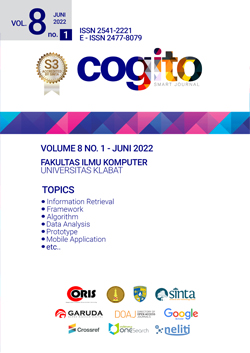LockBit 2.0 Ransomware: Analysis of infection, persistence, prevention mechanism
DOI:
https://doi.org/10.31154/cogito.v8i1.356.232-243Abstract
This research was carried out due to the prevalence of ransomware attacks, especially in Indonesia against data located at Endpoints, in early 2022 ransomware was enough to horrify the news in cyberspace and one of the ransomware that is quite worrying in Indonesia is LockBit 2.0 ransomware, so research is needed against the ransomware. The method used to research the ransomware is static analysis and dynamic analysis which will show the infection and persistence of the LockBit 2.0 ransomware, the static analysis method is used by reverse engineering the portable executable (PE) file and the dynamic analysis method is carried out by running the ransomware. then look at the operating activities, the resources used, and including the network activities carried out by the ransomware and its impact on the affected operating system, so that a scenario for prevention methods can be made, where in this study we can see the real impact of the attacks carried out by the LockBit 2.0 ransomware which is also part of ransomware-as-a-services (Raas), as well as 5 steps that can be taken to avoid it and can make anyone aware with ransomware attacks that’s why create artificial intelligence that accommodates such vigilance is important.Keywords—Ransomware, LockBit 2.0, Infection, Persistence, PreventionReferences
M. J. Haber and B. Hibbert, “Ransomware,” in Privileged Attack Vectors, 2018.
NCSC, “Mitigating malware and ransomware attacks,” Natl. Cyber Secur. Cent., 2020.
H. Alshaikh, N. Ramadan, and H. Ahmed, “Ransomware Prevention and Mitigation Techniques,” Int. J. Comput. Appl., vol. 177, no. 40, 2020, doi: 10.5120/ijca2020919899.
EMSISoft, The State of Ransomware in the US: Report and Statistics 2019. 2019.
M. A. R. Dewi, I. A. Putra, and S. Sulistyo, “DESIGN INTEGRATED HONEYPOT UNTUK DETEKSI DAN IDENTIFIKASI SERANGAN SIBER,” J. IT, vol. 10, no. 3, 2020, doi: 10.37639/jti.v10i3.141.
J. Mulder, “Mimikatz Overview, Defenses and Detection,” 2019.
S. Gadhiya, K. Bhavsar, and P. D. Student, “Techniques for Malware Analysis,” Int. J. Adv. Res. Comput. Sci. Softw. Eng., vol. 3, no. 4, 2013.
N. M. Hai, M. Ogawa, and Q. T. Tho, “Packer identification based on metadata signature,” 2017, doi: 10.1145/3151137.3160687.
S. YusirwanS, Y. Prayudi, and I. Riadi, “Implementation of Malware Analysis using Static and Dynamic Analysis Method,” Int. J. Comput. Appl., vol. 117, no. 6, 2015, doi: 10.5120/20557-2943.
L. Xu, D. Zhang, N. Jayasena, and J. Cavazos, “HADM: Hybrid Analysis for Detection of Malware,” in Lecture Notes in Networks and Systems, vol. 16, 2018.
D. Zhang, Z. Zhang, B. Jiang, and T. H. Tse, “The Impact of Lightweight Disassembler on Malware Detection: An Empirical Study,” in Proceedings - International Computer Software and Applications Conference, 2018, vol. 1, doi: 10.1109/COMPSAC.2018.00094.
E. H. Hwang, S. J. Cho, K. J. Kim, Y. J. Kim, S. H. Yoon, and J. W. Jeon, “A recovery algorithm for PE files in a multi-core system,” 2012.
P. H. Meland, Y. F. F. Bayoumy, and G. Sindre, “The Ransomware-as-a-Service economy within the darknet,” Comput. Secur., vol. 92, 2020, doi: 10.1016/j.cose.2020.101762.
K. Barik, S. Das, K. Konar, B. Chakrabarti Banik, and A. Banerjee, “Exploring user requirements of network forensic tools,” Glob. Transitions Proc., vol. 2, no. 2, 2021, doi: 10.1016/j.gltp.2021.08.043.
A. Ospanova, B. Tuleuov, G. Karzhauova, and L. Kussepova, “Advanced Administration of Windows Based on Open Source Utilities,” in Lecture Notes in Engineering and Computer Science, 2021, vol. 2242.
V. V. Nikulin, “WINDOWS SECURITY AND WINDOWS DEFENDER,” Vestn. Obraz. konsortsiuma Sredn. Univ. Informatsionnye tekhnologii, no. 2, 2021, doi: 10.52374/12569525_2021_18_2_7.
T. H. Kim, G. C. Park, and S. S. Kim, “OS security enhancement system by considering security level,” Int. J. Multimed. Ubiquitous Eng., vol. 2, no. 4, 2007.
M. Bhaganagare, P. Ghongade, P. Jadhav, and S. Nakate, “Customize Linux Operating System and Adding own Feature,” Int. J. Comput. Appl., vol. 109, no. 10, 2015, doi: 10.5120/19224-0889.
R. Diesch, M. Pfaff, and H. Krcmar, “A comprehensive model of information security factors for decision-makers,” Comput. Secur., vol. 92, 2020, doi: 10.1016/j.cose.2020.101747.
M. Krichanov and V. Cheptsov, “UEFI virtual machine firmware hardening through snapshots and attack surface reduction,” 2022, doi: 10.1109/ispras53967.2021.00010.
M. W. Hammond CISA, CRISC, CISSP, “How Do Your IT Controls Measure Up Against The Information Security Triad?,” CPA Pract. Advis., vol. 23, no. 2, 2013.
Downloads
Published
How to Cite
Issue
Section
License
Authors who publish with this journal agree to the following terms:- Authors retain copyright and grant the journal right of first publication with the work simultaneously licensed under a Creative Commons Attribution License that allows others to share the work with an acknowledgment of the work's authorship and initial publication in this journal.
- Authors are able to enter into separate, additional contractual arrangements for the non-exclusive distribution of the journal's published version of the work (e.g., post it to an institutional repository or publish it in a book), with an acknowledgment of its initial publication in this journal.
- Authors are permitted and encouraged to post their work online (e.g., in institutional repositories or on their website) prior to and during the submission process, as it can lead to productive exchanges, as well as earlier and greater citation of published work (See The Effect of Open Access).





























